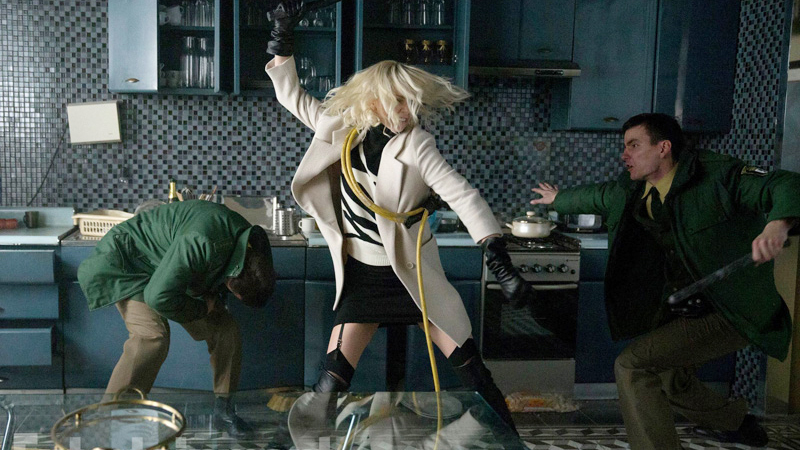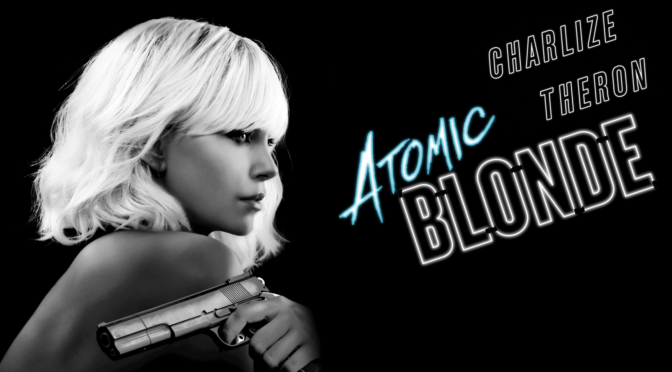Coming off the success of co-directing John Wick, stuntman-turned-director David Leitch left production on the sequel for his first solo outing, Atomic Blonde. Adapted from a graphic novel, the film is a cold war era spy story with Charlize Theron (Mad Max: Fury Road) starring as Lorraine, a British MI6 agent tasked with recovering a list of undercover operatives taken from a killed MI6 agent in Berlin. The setup is familiar with both Skyfall and Mission Impossible using similar plots, but the film distinguishes itself with its unique, stylized action.
From the first frame, Leitch goes for a decidedly anarchic tone. The opening credits and intertitles are spray painted onscreen and the streets of East Berlin are riddled with graffiti and punks. His film breaks against the typical noir with its use of style and energy. Every set is bathed in a seedy neon green, red, or blue and he runs with this aesthetic even more than he did on John Wick. His commitment to this visual style provides a distinct look that is as noticeable as Lorraine’s hair color. Forget neo-noir, Leitch has styled Atomic Blonde as a neon-noir.
The sound design of the film provides a beating pulse to the action. The crack of gunshots is deafening and each strike in the frequent combat scenes creates an ear-splitting thump. Music blares constantly providing an electric or, in one case, ironic backdrop to the violence onscreen. The film uses an 80s heavy soundtrack featuring the likes of Depeche Mode, David Bowie, and even George Michael. Music is almost used as much as this year’s Baby Driver, but unlike that movie, the music never overshadows the action. In most cases, Leitch’s music choice adds a playfulness to the fighting and prevents the film’s violence from becoming too heavy.

And Theron dishes out suffering like a professional. She isn’t the perfect action hero that glides easily through each enemy, nor is she a Jackie Chan-like fighter that stumbles through their encounters. She is tough, resourceful, and unrelentingly brutal. Leitch isn’t as proficient with hand-to-hand combat as he was with gunplay in John Wick. Some of the fight scenes lack the cohesion of better action films, but Leitch and Theron still deliver their fair share of beatdowns. The best of these takes place in apartment building used as a sniping spot by KGB agents where Leitch orchestrates a series of extended takes as Lorraine fights her way through her enemies. It doesn’t hold up to the masterful combat from The Raid and its sequel that the film is clearly mimicking but it does give us a clearer view of the merciless damage these agents inflict on each other without succumbing to the overediting of combat that plagues most action blockbusters today. Her hits land with a ferocity but we still see Lorraine falter. Several of the men are larger than her and their size gives them the upper hand. However, her fighting and her greater characterization are not just defined by her immense skill, but by her tenacity. These protracted fights become less about who is stronger, and more about who continues to come back after each blow. Theron’s defiant glares are the best indication that she has a resilience they can never hope to match.
As a cold war thriller, the plot in encased in paranoia. Lorraine’s orders are to trust no one, even her fellow MI6 agents. Several supposed allies appear, but potential betrayals are lurking around every corner and no one has a clear motive. The narrative can get lost in these turns. One too many reveals near the end start to unravel the story and character motivations leading to more confused shrugs than the shocked gasps the writers hoped for. The plot strains under these repeated twists as they undermine the plausibility of the preceding events. It makes the case for John Wick’s paper-thin revenge story. By using the simplest of setups, that film shifted the audience’s focus to its best feature, the action. Atomic Blonde’s story is its weakest element, but it can be enjoyed for its neon-drenched bloodshed and rousing soundtrack.

3/5 stars.
